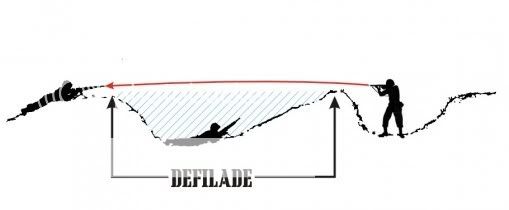NCO Shool Tactical Concepts
Page 1 of 1
 NCO Shool Tactical Concepts
NCO Shool Tactical Concepts
[size=14pt]1st Ranger Battalion
NCO School
Able Company[/size]
[size=12pt]Introduction to Tactical Concepts[/size]
Enfilade
Enfilade is defined as "gunfire directed from a flanking position along the length of an enemy battle line."
"Waiting is bad. Always quickly re-assume your attitudes to both sides, cut the enemies down as they advance, crushing them in the direction from which they attack. Whatever you do, you must drive the enemy together, as if tying a line of fishes, and when they are seen to be piled up, cut them down strongly without giving them room to move."
- Miyamoto Musashi
- Miyamoto Musashi
A formation or position is 'in enfilade' if weapons fire can be directed along its longest axis. For instance, a trench is enfiladed if the opponent can fire down the length of the trench. A column of marching troops is enfiladed if fired on from the front or rear such that the projectiles travel the length of the column. A rank or line of advancing troops is enfiladed if fired on from the side (flank).
The benefit of enfilading an enemy formation is that, by firing along the long axis, it is easier to hit individual troops within that formation. Adjusting the elevation of the weapon merely directs the fire to a different point along the axis of the formation, although traversing the weapon is more likely to result in a miss. Enfilade fire takes advantage of the fact that aiming at a target is easier than correctly estimating the range to avoid shooting too long or short. Finally, projectiles that miss an intended target are more likely to hit a different target within the formation if firing along the long axis.
If you are lucky and the enemy is lined up enfilade to you things are tilted in your favor. If you miss your target, or have a weapon with enough juice to punch clean through, there may be another unlucky sap over there that you will hit. All you have to do to engage this cluster of enemy is change the elevation (move your sights up or down) of your fire.
This is an example of what Enfilade fire is not. The gunman needs to engage his targets individually, not along a set axis.

This is an example of what Enfilade fire is. The gunman can engage his targets all at once.

An idea to toss around in your head is exactly how you can catch the enemy in this situation.
You may just be lucky and catch them napping, you could channel your opponents by choosing a good area with obstacles like tank traps, boxes, barrels, and sandbags. You can also take advantage of positioning yourself so that streets, hallways and other features that 'line em up' can do the work for you.
Conversely, remember that THEY are looking to this exact same thing to YOU!
Defilade
A tactical concept that goes hand in hand with enfilade is "defilade". Defilade is defined as: "to arrange (troops and fortifications) so that the terrain will protect them, esp. from gunfire against either flank"
Defilade is cover but 'different'.

By now you should have a solid understanding of what cover is (solid?...get it?). For practical purposes I will define cover as an object of some sort that you place between yourself and the bullets flying at you. Defilade is the use of terrain or elevation so as to prevent your opponent from engaging you with direct or line of sight fire.
While bullets travel in an arc, that arc is too shallow to be able to engage targets that are depressed far enough below your position so that they are out of sight. Areas that you cannot engage with direct fire are also known as dead space.
Dead space issues in combat are what lead to the development of such weapons as mortars, grenades, claymore mines, bombs and other such cool toys. You have to place a mine or drop something into a defiladed position to take it out; or else you have to maneuver into a position that allows you to fire into it.
If you are able to flank a defiladed position, many times it turns into a "fish in a barrel" situation because the targets are then able to be taken in enfilade. An example would be jumping into an enemy trench and firing straight down it. The enemies are all channeled right in front of you. This is what happened when Union forces were able to flank the "Bloody Lane" during the center action at the Battle of Antietam.
For our purposes, we want to be aware of areas that can keep us out of the enemies line of fire. Sunken walkways, landscaping hills, folds in the land and ditches all can provide you with an area where someone shooting at you wont be able to hit you. And fortunately mortars are in short supply for our operations.
Remember:
Amateurs practice until they get it right. Professionals practice until they get it wrong.
And as always:
[size=14pt]Prior Preparation Prevents Piss Poor Performance
Copyright 2011, All rights reserved.
Do not use, alter, change, or quote outside of this thread without explicit written permission.
Page 1 of 1
Permissions in this forum:
You cannot reply to topics in this forum|
|
|
